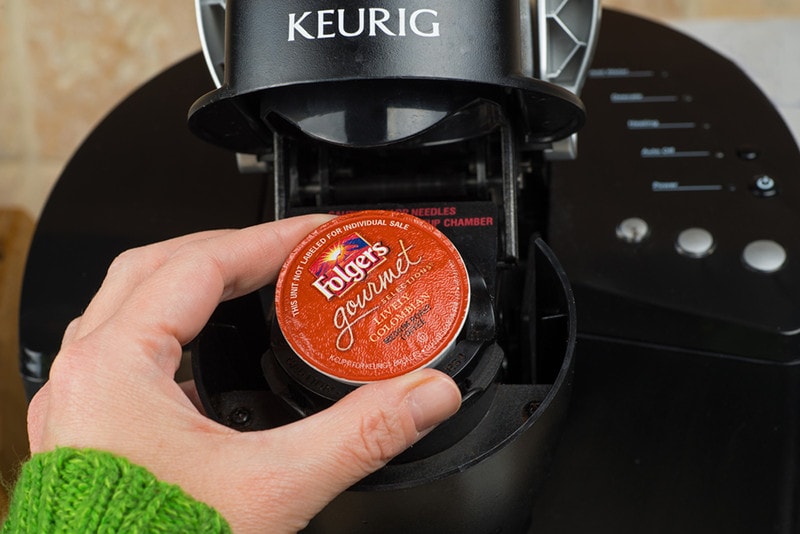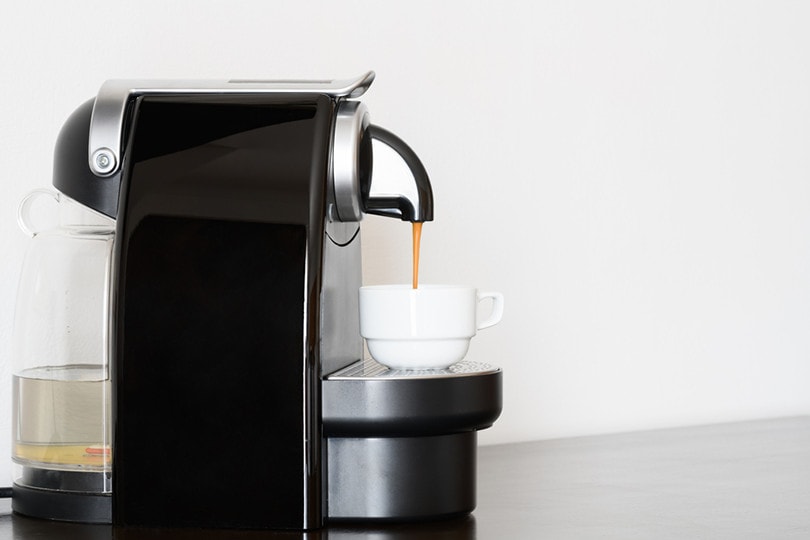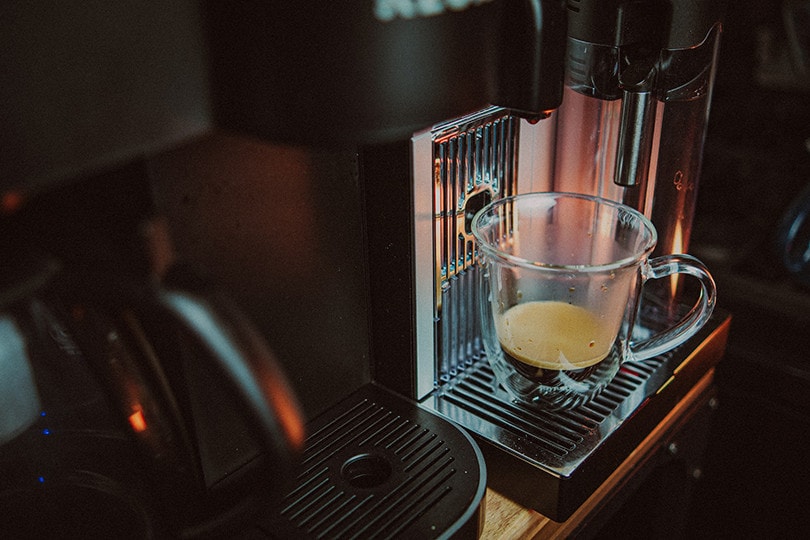Are K Cups Recyclable? Facts & FAQ
-

- Last updated:

K-cups (also known as coffee pods) hit the coffee scene around 1998 thanks to the Keurig coffee maker company. These small, single-cup brewing pods allow for quick and easy coffee-making for avid coffee drinkers who prefer to make their brew right at home. But are K-cups recyclable? K-Cups are made from a combination of paper, coffee grounds, aluminum, and plastic. These pods are recyclable, but the components will need to be separated beforehand. Unfortunately, the whole pod itself can’t be recycled.
How to Properly Dispose of K-Cups

You may be tempted to just throw K-cups in the trash, but that’s not recommended. It can be wasteful, especially if you have one or multiple K-cups per day. Instead, you can separate the different parts of the K-cup and recycle them.
For example, the plastic cup itself can be placed with other plastic recyclables in the recycling bin. But you must dispose of the coffee grounds first. Those you can throw away, or you can add them to a compost bin. Then, rinse the cup before tossing it in the recycling. The aluminum lid can be recycled with other aluminum products, but again, make sure that it is clean first.
If you prefer an easier option (one that doesn’t require disposal), one alternative is to buy a reusable K-cup and add your own coffee grounds to it. This doesn’t produce as much waste, but you will have to clean it often.
Other Commonly Asked Questions About K-Cups
What Exactly Is a Keurig?
Keurig is a brand of single-cup home brewing machines that’s been around since the 1990s. These fancy machines make a single cup of coffee, tea, hot chocolate, or other beverage by using small pods filled with ounces of ground coffee and other ingredients. So, when you own a Keurig machine, you won’t need to buy pre-packaged containers of coffee. Instead, you can use your Keurig to brew any type of ground coffee that suits your tastes.
Are There Different Types of K-Cups?
There are several types of K-cup coffee, but the most notable difference is the type of coffee that is used. There are various levels of coffee “magnitude,” with the most common being coffee strength. Although all K-cups are equal in terms of how much coffee they contain, the coffee strength will affect the coffee’s taste and effect on the body and texture of the coffee.
Is There a Difference Between K-Cups and K-Cup Pods?
No, they’re used interchangeably to describe the same thing – a coffee pod (with a filter) that makes a single cup of coffee. These cups have become incredibly popular throughout the years, and for good reason.
Not only do they allow you to make a single cup of coffee like you normally would, but they are also much easier to clean than a normal brewer. You can just throw them away (or recycle them). Plus, if you’re the type of person who likes to try out new coffee flavors or other instant-formula hot beverages (such as tea or hot cocoa), you can do so without ever having to leave your kitchen because they come in multiple flavors and varieties.
Are Keurigs Still Bad for the Environment?
Short answer? Yes, some are, but only if you are using a certain type. However, the problem here lies in the fact that so many brands (other than just Keurig) have started to create their K-cups. This means that there are a lot of different types of K-cups in the marketplace, many of which can’t be recycled. Even if you have a recyclable K-cup, you’ll need to make sure that it’s being disposed of properly. So, it’s best to read the label on the packaging, or the tossed cup could end up in a landfill.
Does Bacteria Build Up in Keurig?
It can. But as long as your Keurig is being properly maintained, then you shouldn’t have any issues with bacteria building up. While this can be a concern with other coffee makers, it’s not something you have to worry about with a Keurig.
The main problem with a Keurig is that water is added to the machine before it’s ready to brew and steam plus mineral deposits can start to form. If you’re using a Keurig and notice that the water is starting to smell a bit rancid, then you may want to clean it following the directions in the manual.

How Long Do K-Cups Take to Decompose?
While it’s impossible to know exactly how long it will take for a K-Cup to decompose, we can look at average time ranges for biodegradable materials. Cardboard takes about 6 months to decompose, which is considered fast by all accounts. Plastic, a common material in these cups, can take anywhere from 20 to 500 years to fully decompose.
Do K-Cups Have Aluminum?
Many coffee drinkers raise questions about aluminum and K-cups because they’re worried about aluminum leaching into their coffee beans. The truth is that many K-cups have aluminum on the top of the filter. Aluminum in small amounts is not harmful, but ingesting large amounts of aluminum can be toxic. However, you don’t have to worry too much about aluminum getting into your coffee with K-cups.
Are K-Cups Made with BPA-Free Plastic?
Yes. Although they are made with BPA-free plastic, the K-cups may contain traces of other chemicals that are used to make plastic. To break this down a bit further. There are two types of plastics: thermoplastics and thermosets. Thermoplastics are easily molded and melt when heated, whereas thermosets cannot be heated. The main difference between these two types of plastics is their durability.
Thermoplastics will break down over time if exposed to heat or UV rays, whereas thermosets will not experience this degradation. K-cups can be made from either type of plastic; however, some brands specifically make their cups out of thermoplastics. If you choose to use a K-cup made from thermoplastics, it would be best to choose one that is BPA-free and labeled as such.
How Often Should a Keurig Be Replaced?
You should replace your Keurig every 3 to 6 years. While this may seem like a long time, it’s important to remember that Keurig models aren’t exactly standardized. The same way that a K-cup and a whisky cup are different and must be matched, so must the machine be matched to the pod. If the shape and design of the K-cups ever changes, your machine may not be compatible with the new design.

Can I Run Bleach Through My Keurig?
Bleach is not an approved cleaner for Keurig machines. It can actually damage the machine, as well as the beverage inside of it. What can you use? There are a few different approved Keurig cleaners available, but vinegar is a great natural option – and it’s the most recommended. On top of that, it’s inexpensive, and it works just as well as a commercial cleaner. If you notice any mineral stains inside of your machine or that it starts to emit a bad odor, giving it a good cleaning with diluted vinegar can definitely help with these issues.
Final Thoughts
So, there you have it. K-cups can be recycled, but overall, they aren’t the most biodegradable product. And if you’re looking for something that is better for the environment, it’s best to find a reusable K-cup coffee option. This way, you won’t have to worry about tossing it in the trash after every cup.
See Also:
- Are Chip Bags Recyclable? How Do You Properly Dispose of Them?
- Are Pringles Cans Recyclable? How Do You Properly Dispose of Them?
Featured Image Credit: Rob Hainer, Shutterstock
Contents

